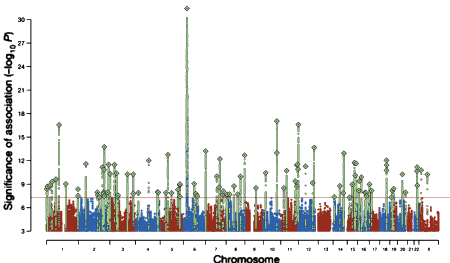 Gregor Mendel was an Augustinian Monk in Moravia whose studies of plant inheritance brought such things into the realm of science. My sister’s blue eyes meant that both of our
Gregor Mendel was an Augustinian Monk in Moravia whose studies of plant inheritance brought such things into the realm of science. My sister’s blue eyes meant that both of our ![Gregor Mendel [1822-1884] Gregor Mendel [1822-1884]](http://1boringoldman.com/images/mendel-1.gif) brown-eyed parents carried recessive blue-eye genes. The postman was out of the picture. Mendel’s schemes of inheritance were like that – very precise statistical predictions based on dominant genes. Things stayed pretty clean through Watson and Crick’s images of the double helix DNA structure, even Nirenberg’s nucleotide code sequences. But then things got out of hand…
brown-eyed parents carried recessive blue-eye genes. The postman was out of the picture. Mendel’s schemes of inheritance were like that – very precise statistical predictions based on dominant genes. Things stayed pretty clean through Watson and Crick’s images of the double helix DNA structure, even Nirenberg’s nucleotide code sequences. But then things got out of hand…
![]()
 The Human Genome Project was completed in draft form in 2000, and declared finished in 2003. With that, they left most of us mere mortals in the dust with their volumes and volumes of books filled with Cs, As, Ts, and Gs running on towards the end of time. And so much for pea plants, eye color, dominance, etc. It starts with a gene being "a locatable region of genomic sequence, corresponding to a unit of inheritance, which is associated with regulatory regions, transcribed regions, and or other functional sequence regions" and complexifies geometrically from there. We thought it would be easy, but that was just a dream some of us had [as a kid, I set out to count the stars too].
The Human Genome Project was completed in draft form in 2000, and declared finished in 2003. With that, they left most of us mere mortals in the dust with their volumes and volumes of books filled with Cs, As, Ts, and Gs running on towards the end of time. And so much for pea plants, eye color, dominance, etc. It starts with a gene being "a locatable region of genomic sequence, corresponding to a unit of inheritance, which is associated with regulatory regions, transcribed regions, and or other functional sequence regions" and complexifies geometrically from there. We thought it would be easy, but that was just a dream some of us had [as a kid, I set out to count the stars too].
by the Schizophrenia Working Group of the Psychiatric Genomics ConsortiumNature. 2014 511:421–427.
Schizophrenia is a highly heritable disorder. Genetic risk is conferred by a large number of alleles, including common alleles of small effect that might be detected by genome-wide association studies. Here we report a multi-stage schizophrenia genome-wide association study of up to 36,989 cases and 113,075 controls. We identify 128 independent associations spanning 108 conservatively defined loci that meet genome-wide significance, 83 of which have not been previously reported. Associations were enriched among genes expressed in brain, providing biological plausibility for the findings. Many findings have the potential to provide entirely new insights into aetiology, but associations at DRD2 and several genes involved in glutamatergic neurotransmission highlight molecules of known and potential therapeutic relevance to schizophrenia, and are consistent with leading pathophysiological hypotheses. Independent of genes expressed in brain, associations were enriched among genes expressed in tissues that have important roles in immunity, providing support for the speculated link between the immune system and schizophrenia.

This genome wide association study revealed 108 different loci where variations were associated with schizophrenia; 83 of these had not been reported previously. Note, these are not “108 genes for schizophrenia.” These are areas of the genome where variations in sequence are associated with schizophrenia. Most of these are not in or even near genes. And any one of these 108 regions contributes only a tiny fraction of risk in the population…
If my name were among the army of authors [302 total] on this study, I’d be proud too. They strengthened the case for a strong genetic loading in Schizophrenia [though most of us already accept that formulation]. Their large study contains variations found in previous studies [confirmation]. They’re intrigued by the regions being near areas already implicated in Schizophrenia research. And I expect the wheels are turning for the next steps based on these findings. Steven Hyman at the Stanley Institute is no doubt beside himself thinking about the coming $650 M from Mr. Stanley and Tom Insel is pretty excited too.
In my understanding of things, this is light years this side of finding a/the cause for Schizophrenia, much less a treatment. But it’s undoubtedly going in the right direction. To my way of thinking, it strengthens the case that there [are][is a] biological [causes][cause] to look for. But in terms of right now, it in no way dissuades me from the point of the last post. Those currently afflicted need our help and aren’t getting what they need. Not one of the chronic psychotic people alive right now is going to be helped by these findings, and they desperately need a lot more help than we’re giving them – in our lifetime – and in their lifetimes…

In my graduate program we were taught to ask the question; did we make the right decision with the information we had at hand? The reality is data collection can go on forever and hind sight is 20/20. We also have to consider the time we have to deal with an issue, some need immediate attention and some have the luxury of time.
When a person slides off a curve in the road it is great to think about coefficients of adhesion, the radius of the arc, and other design parameters. The reality is the first thing you do is see if someone is hurt and get their car out of the ditch.
The same applies to medicine. The first thing is getting some very ill people into a safe environment where they can receive appropriate care. Jail and prison is not an appropriate care facility.
I hope, like everyone, that this research pays off, but maybe a little redirection of funding is in order to relieve the immediate needs of a growing disserved population.
Steve Lucas
Amen!
Biological cause or correlates or vulnerabilities? Biological vulnerability does not mean that a biological (I.e., drug) treatment is required. Not only can we divert research to helping those afflicted today, we can also divert resources to interventions that might be effective even though we may not understand the biological basis for that effect. I do not know exactly what is happening in my brain to know that I am learning from you and that the time I spend reading these posts is worthwhile and informative.
That project was launched with the assumption that 99% of our DNA was “junk” by many who were taking part in it. The sciences really do need to be taken with a grain of salt at times. There is enough hubris and presumptuousness among the sciences to justify a little distancing from grand projects and even grander conclusions. Cynicism isn’t called for, but enough inspection might make it clear that cynicism is at the bottom of many scientific pursuits, these days.
But then again, scientific thinking requires a certain degree of skepticism and rational inquiry rather than unthinking slavish devotion to the produce of scientists. not to mention corruption and unexamined biases. Scientists should not be on a pedestal right now. Some should be on a whipping post.
Looking for needles in haystacks – while postponing everyday human needs for safety, nutritious food, a home, friendly company, love and meaning…
We would be better served by securing basic needs first. The other way is an ambitious and costly long shot
The hunger winter in the Netherlands during WWII reportedly produced more mentally ill persons diagnosed with schizophrenia. I expect the horrible massacres in Gaza these days may produce more of what is called mental illness too, wheras in reality people are hurt by being subjected to immensely traumatic killings and destruction. What happened to you, is that too simple a qustion to ask? There probably are people who are more liable to intense suffering than others, due to great sensitivity and empathy, which in itself are positive traits, but difficult to live with in a hard, unjust world. Just look at the guys raining bombs on civilians, held as normal. I would not call them schizophrenic but most dangerous, controlled, umempathic, insensitive… Most human suffering called mental illness is due not to genes but bad luck and/or inhumane circumstances
As for genetics, the author Knut Hamsun touches on the subject indirectly in his book The women at the (water)pump, from around 1920. The couple Petra and Oliver have a brood of brown-eyed children, in spite of Oliver’s accident making him maroder man, i e weak, lame, infertile. At the birth of a blueeyed girl, the blueeyed Oliver suspects infidelity from his wife the blueeyed Petra, all the time employed in the houshold of the rich, browneyed “konsulen” who owns most of the small community. Oliver calls his youngest daugher “blåveisen”, name of a beautiful spring flower, a blue wood anemone. I’ll be as ignorant as Oliver, unable to critically evaluate this research, as are most of us, I think.
Sandy,
Right now, our antipsychotics are symptomatic treatments with a large downside that is particularly marked for long term use. I’m not an anti-medication person in general. But with these drugs, people who are “pro-medication” have to deny both the reported experiential effects of the drugs and their long-term disabilities. These drugs should only be used by doctors and patients with “eyes wide open.” The dream of a benign and well-tolerated drug for psychosis is currently “only a dream.”
berit,
“Looking for needles in haystacks – while postponing everyday human needs for safety, nutritious food, a home, friendly company, love and meaning…”
Exactly! I don’t mind them looking for those needles. But the glaring absence of right-thinking priorities in the US handling of severe mental illness way outweighs their inordinate focus on “science fun.”
Genetic research is preferably funded over government programs that intervene to make people’s lives better because the latter are considered socialist, redistributing money from successful haves to incapable have-nots. Technical discoveries are presumed to make money for everyone. Such are US priorities.
That’s not the problem.
The issue is that the chronically mentally ill don’t vote nor hold big fundraisers for politicians. Geneticists and their venture capitalists who want grant money do.